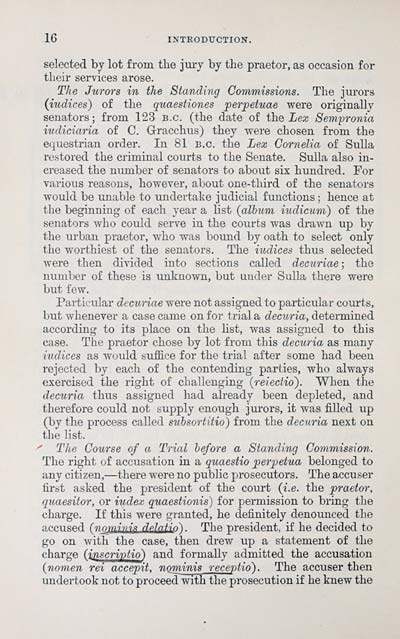Download files
Complete book:
Individual page:
Thumbnail gallery: Grid view | List view

16 INTRODUCTION.
selected by lot from tlie jury by the praetor, as occasion for
their sei-vices arose.
The Jiirors in the Standing Commissions. The jurors
(iudices) of the quaestiones perpetuae were originallv
senators; from 123 b.c. (the date of the Lex Sempronia
iudiciaria of C. Grracchus) they were chosen from the
equestrian order. In 81 b.c. the Lex Cornelia of Sulla
restored the criminal courts to the Senate. Sulla also in-
creased the number of senators to about six hundred. For
various reasons, however, about one-third of the senators
would be unable to undertake judicial functions ; hence at
the beginniug of each year a list {albiim iudicum) of the
senators who could serve in the courts was drawn up by
the urban praetor, who was boimd by oath to select only
the worthiest of the senators. The iudices thus selected
were then divided into sections called decuriae ; the
number of these is unknown, but under Sulla there were
but few.
Partieular decuriae were not assigned to particular courts,
but whenever a case came on f or trial a decuria, detennined
according to its place on the hst, was assigned to this
case. The praetor chose by lot from this decuria as many
iudices as would sufl&ce for the trial after some had beeu
rejected by each of the contending parties, who always
exercised the right of challenging {reiectio). When the
decuria thus assigned had already been depleted, and
therefore could not supply enough jui-ors, it was fiUed up
(by the process called subsortitio) from the decuria next ou
the hst.
" The Course of a Trial before a Standing Commission.
The right of accusation in a quaestio perpetua belonged to
any citizen, — there were no pubhc prosecutors. The accuser
tirst asked the president of the court {i.e. the praetor,
quaesitor, or iudex quaestionis) for permission to bring the
charge. If this were granted, he definitely denounced the
accused f nnmini^s d.eln.tin ) . The president, if he decided to
go on with the case, then drew up a statement of the
charge ( inscriptio) and formally admitted the accusation
(nomen rei accepit, no minis recep tio). The accuser then
undertook not to proceed with the prosecution if he knew the
selected by lot from tlie jury by the praetor, as occasion for
their sei-vices arose.
The Jiirors in the Standing Commissions. The jurors
(iudices) of the quaestiones perpetuae were originallv
senators; from 123 b.c. (the date of the Lex Sempronia
iudiciaria of C. Grracchus) they were chosen from the
equestrian order. In 81 b.c. the Lex Cornelia of Sulla
restored the criminal courts to the Senate. Sulla also in-
creased the number of senators to about six hundred. For
various reasons, however, about one-third of the senators
would be unable to undertake judicial functions ; hence at
the beginniug of each year a list {albiim iudicum) of the
senators who could serve in the courts was drawn up by
the urban praetor, who was boimd by oath to select only
the worthiest of the senators. The iudices thus selected
were then divided into sections called decuriae ; the
number of these is unknown, but under Sulla there were
but few.
Partieular decuriae were not assigned to particular courts,
but whenever a case came on f or trial a decuria, detennined
according to its place on the hst, was assigned to this
case. The praetor chose by lot from this decuria as many
iudices as would sufl&ce for the trial after some had beeu
rejected by each of the contending parties, who always
exercised the right of challenging {reiectio). When the
decuria thus assigned had already been depleted, and
therefore could not supply enough jui-ors, it was fiUed up
(by the process called subsortitio) from the decuria next ou
the hst.
" The Course of a Trial before a Standing Commission.
The right of accusation in a quaestio perpetua belonged to
any citizen, — there were no pubhc prosecutors. The accuser
tirst asked the president of the court {i.e. the praetor,
quaesitor, or iudex quaestionis) for permission to bring the
charge. If this were granted, he definitely denounced the
accused f nnmini^s d.eln.tin ) . The president, if he decided to
go on with the case, then drew up a statement of the
charge ( inscriptio) and formally admitted the accusation
(nomen rei accepit, no minis recep tio). The accuser then
undertook not to proceed with the prosecution if he knew the
Set display mode to: Large image | Transcription
Images and transcriptions on this page, including medium image downloads, may be used under the Creative Commons Attribution 4.0 International Licence unless otherwise stated. ![]()
| Early Gaelic Book Collections > Matheson Collection > Pro S. Roscio Amerino > (24) |
|---|
| Permanent URL | https://digital.nls.uk/76502596 |
|---|
| Description | Items from a collection of 170 volumes relating to Gaelic matters. Mainly philological works in the Celtic and some non-Celtic languages. Some books extensively annotated by Angus Matheson, the first Professor of Celtic at Glasgow University. |
|---|
| Description | Selected items from five 'Special and Named Printed Collections'. Includes books in Gaelic and other Celtic languages, works about the Gaels, their languages, literature, culture and history. |
|---|

